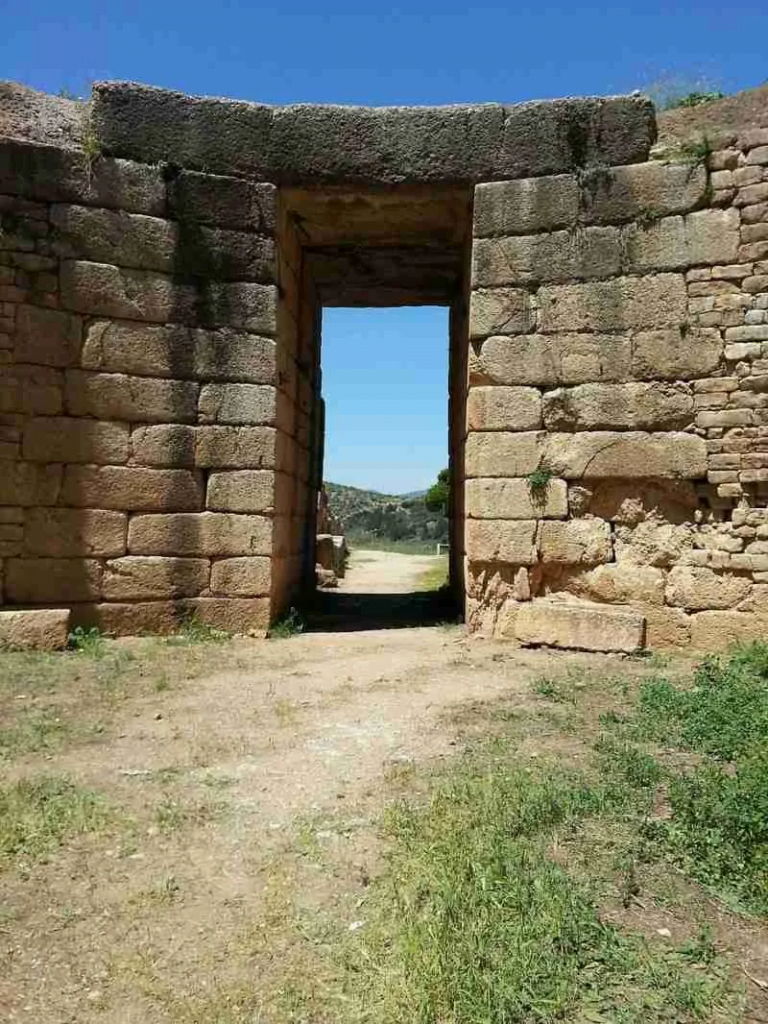Mycenae in an impressive 3D representation
“Polychryses Mycenae”, the kingdom of the mythical Agamemnon, first praised by Homer in his epics, is the most important and richest palatial center of the Late Bronze Age in Greece.

Their name has been given to one of the most brilliant civilizations of Greek prehistory, the Mycenaean, and the myths associated with their history spanned the ages with the Homeric epics and the great tragedies of the classical era, while they inspired and continue to inspire worldwide the intellectual creation and art

The mythical tradition mentions Perseus as the founder of Mycenae, son of Zeus and Danae, daughter of Acrisios, king of Argos, descendant of Danaus. Pausanias (2.16.3) states that Perseus named the new city Mycenae either because the fungus of his sword fell there or because a spring of abundant water, the Perseus spring, was discovered there under the root of a “fungus”, i.e. a mushroom. According to the myth, the descendants of Perseus reigned in Mycenae for three generations, the last being Eurystheus, who was killed without leaving descendants, and so the inhabitants of Mycenae chose as their king Atreus, son of Pelops and father of Agamemnon and Menelaus.

Mycenae was founded between two high conical hills, Prophet Ilias (805 m.) and Sara (660 m.), on a low rise that dominated the Argolic plain and controlled road and sea communications. The earliest human activity in the area is documented by minimal remains due to the later building phases and dates back to the 7th millennium BC, during the Neolithic era. The habitation was continuous until historical times, but most monuments, which are visible today, belong to the heyday of the area, the Late Bronze Age, between 1350 and 1200 BC. At the beginning of the 2nd millennium there was a small settlement on the hill as well as a cemetery on its south-west side, with simple burials in pits. Around 1700 BC hegemonic and aristocratic families appeared, as evidenced by the use of monumental tombs, richly endowed and enclosed in a stone enclosure, called Burial Circle B. This development continued at the beginning of the Mycenaean period, around 1600 BC, when a large central building on top of the hill, a second stone enclosure, Burial Circle A, as well as the first vaulted tombs. As the finds prove, the rulers of Mycenae were powerful and participated in a complex network of trade transactions with the countries of the Mediterranean.

The reconstruction of the palaces, which are visible today, began around 1350 BC, in the Late Helladic IIIA2 period. Then the fortification of the acropolis began, in which three phases can be distinguished. The first enclosure was built with the cyclopean system on top of the rock. A hundred years later, in the HY IIIB1 period, the fortification was moved to the west and south and the Lion Gate, the monumental entrance with its rampart, was built.

The walled area was joined by the religious center and Burial Circle A, which was transformed into an ancestor worship space, by raising its original level. Then it is possible that the vaulted tomb known as the “treasure of Atreus”, with its huge lintels and high honeycomb dome, was also built. Around 1200 BC, in the HY IIIB-C period, after an extensive destruction, probably due to an earthquake, the extension of the walls to the northeast of the hill was built in order to include the underground fountain in the walled area. Successive disasters accompanied by fires led to the final abandonment of the site around 1100 BC.

After the collapse of the palace system and the dissolution of the “Mycenaean Common”, the hill remained sparsely inhabited until the classical period. During this time, local hero cults were created in the area, due to the fame of Mycenae, which the Homeric epics carried throughout the Greek world, while an archaic temple dedicated to Hera or Athena was founded on the top of the hill. In 468 BC, after the alfalfa wars in which the city participated, Argos conquered it and demolished parts of its fortifications. Later, during the Hellenistic period, the Argites established a “komi” on the hill, repairing the prehistoric walls and the archaic temple and building a small theater above the road of the vaulted tomb of Clytemnestra. In the following centuries the town remained almost abandoned and was already in ruins when Pausanias visited it in the 2nd century. A.D.

The cyclopean walls of the Mycenaean acropolis, however, remained visible over the centuries and were a pole of attraction for many travelers and archeologists, who did not hesitate to loot the area during the 18th and 19th centuries, rewarded by the indifference and avarice of the Turks. In 1837, after the liberation of Greece, Mycenae was placed under the auspices of the Athens Archaeological Society, which still carries out research in the area. In 1941 its representative, K. Pittakis, cleaned the Gate of Lions and in 1876, after small test cuts in 1874, Henry Schliemann began his great excavation, which revealed the five tombs of Burial Circle A, under the supervision of P. Stamatakis, who continued the work between 1876-1877, revealing the sixth tomb.
Subsequently, excavations in the palaces and cemeteries were carried out by H. Tsoundas (1884-1902), D. Evaggelidis (1909), G. Rosenwaldt (1911), A. Keramopoulos (1917), and A.J.B. Wace (1920-1923, 1939, 1950-1957). At the same time, I. Papadimitriou and G. Mylonas of the Archaeological Society excavated Burial Circle B and houses, during the years 1952-1955, while G. Mylonas together with N. Verdelis of the Archaeological Service, excavated parts of the settlement.

Excavations by the British School of Archaeology, under the supervision of Lord W. Taylor, revealed the religious center, while investigations were continued by the Archaeological Society with G. Mylonas and Sp. Iakovidis in 1959 and 1969-1974. Restoration work was carried out in 1950-1955 by A. Orlandos and E. Stikas in the vaulted tomb of Clytemnestra, in the palace, in the area around the Gate of Lions and in Burial Circle B. Since 1998, the project “Conservation -Consolidation-Elevation of the Monuments of the Acropolis of Mycenae and the Wider Surrounding Area”, which was initially undertaken by the Working Group for the Maintenance of Epidaurus Monuments and then by the Mycenae Committee, created in 1999 by the Ministry of Culture.

With the help of technology we have the opportunity to see Mycenae as it really was in ancient times. Then watch an amazing documentary about the acropolis of Mycenae in 3D.



